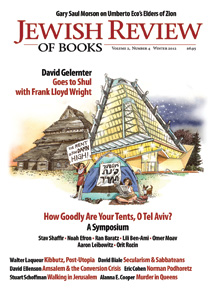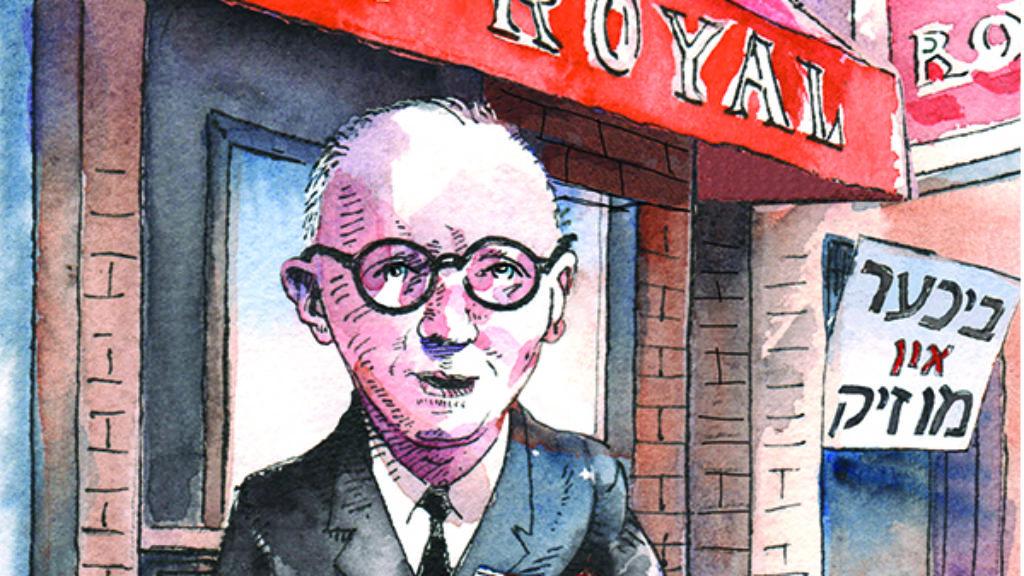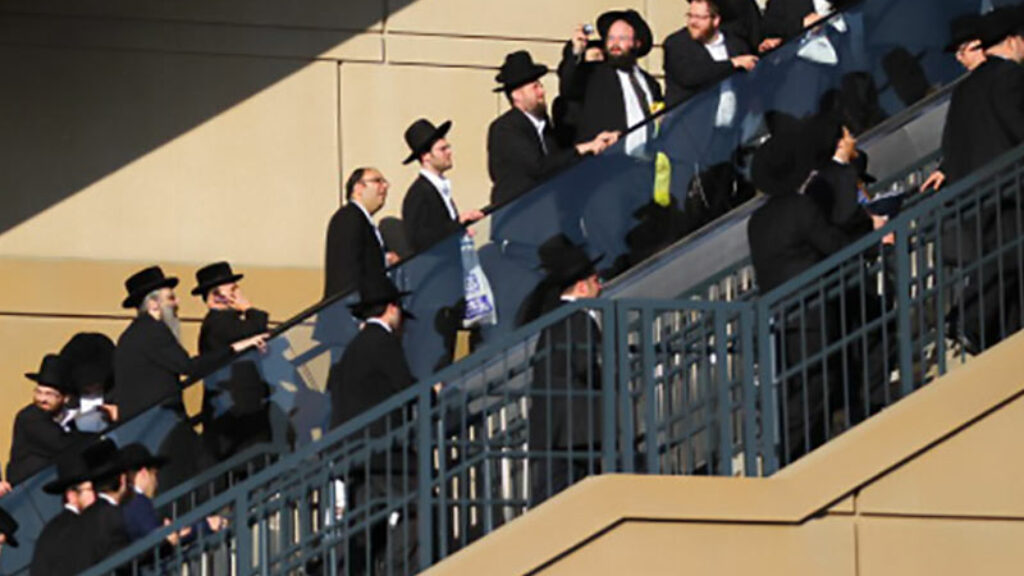Letters, Spring 2012

The Bimah Takes Center Stage
Having read and enjoyed every word on every page of every single past issue of the Jewish Review of Books, I waited with impatience for the Winter 2012 edition to arrive. Nor was its arrival disappointing. The opening piece, David Gelernter’s “A Tale of Two Synagogues,” was especially well done.
I hope not to appear churlish or ungrateful, therefore, if I mention one quibble: Gelernter correctly sees the altar in the center of domed Christian churches as the exception to the rule that the “domed building, one of architecture’s grandest gestures is a thriller without a finish.” When he goes on, however, to complain that the “altar is a sacred zone where priests officiate and laymen are out of place,” I believe this theological observation may reveal a historical misunderstanding. In ancient and traditional Christian churches, the position of the altars frequently came first; they were often placed over the graves of the martyred saints. The circumambient architecture arrived later.
Perhaps this point is more apparent if one compares the two Roman buildings to which Gelernter refers: the Pantheon and St. Peter’s Basilica. In the case of the latter, the position of the altar was determined long before a dome was even considered; it was placed over the tomb of the apostle. From an architectural (as distinct from a theological) perspective, the arrangement has an obvious integrity. When, however, Christians later tried to make the Pantheon into a church building, the attempt was—I hope Gelernter will agree—a failure; even today that added altar is an offense to the architecture.
Patrick Henry Reardon
Senior Editor,
Touchstone: A Journal of Mere Christianity
Chicago, IL
“A Tale of Two Synagogues” by David Gelernter: what a great article, so well written, so much insight, so much content, just delicious.
As a Philly rabbi, I especially appreciated the article, having known Rabbi Mortimer Cohen and having watched Beth Sholom being built (the plastic panels for the roof replaced glass, which could not be tempered at the time). Despite Thomas Wolfe’s assertion, I did go home again when I became the interim rabbi at Beth Sholom.
The author is so correct about the central emptiness of the sanctuary. Upon entering, you feel the soaring open space standing on the sands of Sinai and looking up to the top of the mountain. But, like so many post-World War II synagogues, the central space is empty and the bar mitzvah youngster is told to face the audience.Now I serve historic Congregation Kesher Israel in Society Hill, which was established in 1889, and, perfectly, the bimah is in the center.
Rabbi Fred Kazan
Merion Station, PA
David Gelernter Responds:
Patrick Reardon makes a good point about the placement of altars—and I certainly agree with him about the Pantheon. But the architectural question centers on the very different functions of a centrally-placed altar versus a bimah. And of course, no matter where the altar might be fixed, a church can be centered on the altar or allowed to surround it asymmetrically (so that, for example, the high altar is east of the crossing and choir, as in most large gothic churches). I thank Rabbi Kazan for his letter.
Chutzpah or Khezbh’n hane’fesh?
Dr. Ruth R. Wisse, professor of Yiddish at Harvard University, makes a case against a group of Yiddish writers who, in their enthusiasm for Soviet Communism and revolutionary policies, did not condemn strongly enough the Arab attacks on Jewish settlements in Palestine in 1929, which resulted in the deaths of over 100 Jews (“Drowning in the Red Sea,” Fall 2011). Although a group of Yiddish writers, in protest, resigned from the Yiddish newspaper the Freiheit for justifying the attacks by the Arabs as a demand for “independent worker-and-peasant land for the masses” and calling them a legitimate opposition to the “Jewish fascists who had provoked the riots,” Professor Wisse feels that the writers, my father H. Leivick included, were not more forthright, or more principled, in their denunciation of these attacks, even as they dissociated themselves from the Communist Freiheit.
In some respects I can see Wisse’s point: This was a time of transition, a period when hopes for a “New World” ran high and were in the minds and hearts of many progressive and left-leaning writers and intellectuals. She writes that there was “an attempt to hold the middle ground between some claims of Jewishness and fealty to Communism.” True, but why such bitter attacks against the group—a group of writers (all deceased and unable to defend themselves) and intellectuals who saw in that movement the possibility of economic equality, the rising of the working class, social justice, Jewish renewal, and the resurgence of Yiddish culture?
The fact that some of the writers did not display greater concern for the “fate of the Yishuv” (the Jewish settlement in Palestine) is regrettable, a shortcoming on their part. Though they quit the Freiheit, they still felt obligated to “prove their internationalist leftist credentials” (as did many intellectuals, writers, artists, musicians, and academics of that period). There were moral and judgment lapses along the way, for which Professor Wisse finds considerable space and energy to condemn and to demean.
During his visit to the Soviet Union in the 1920s, Leivick was witness to the oppression of many of Russia’s citizens, which created ambiguity in his attitude toward the Soviet Union, but he resisted compromising his ideals and his hopes for social justice, for the equality of man, for the dignity of the working class. Voch, a publication of which my father was the editor, adhered to the ideals of socialism and was sympathetic to the leftist causes and aspirations. The publication was not anti-Zionist, but rather more in favor of the idea of Birobidzhan as an alternative to Palestine.
Professor Wisse takes H. Leivick to task for his critical assessment of America’s “faltering Jewish spiritual life, the dullness of its institutions, and the failure of visionary leadership in the Yiddish press.” She says that H. Leivick hailed, as an “antidote” to these ills, the recent establishment in New York of the leftist Yiddishe kultur gezelshaft, the Organization of Yiddish Culture.
In the unkindest cut of all, Professor Wisse takes her scalpel to the hearts of the Yiddish writers’ consciences, questioning, “what moral credit Yiddish writers like Shapiro, Leivick, and Leyeles—writers of the highest order—were prepared to extend the Soviet Union, even after ostensibly declaring their independence from it.” Wisse continues, “One wishes that they had eventually undertaken their own self-accounting, whether in the form of khezbh’n hane’fesh (personal account of the soul) that Judaism considers indispensible to the moral life. or objectively, to help us better understand this phase of cultural history.”
Such audacity, such chutzpah on the part of Professor Wisse, that she dares question my father’s moral conscience, my father’s deep and abiding concern for the individual and for humanity. Perhaps the following excerpt from a conversation with Jacob Pat, in 1954, might enlighten the professor (from Conversations with Yiddish Writers):
Pat writes of asking H. Leivick, “You have always, it seems, been drawn to the world, I say to him—to be part of the world. You have been in Poland, in France, in Argentina, twice in Eretz Yisrael, the German D.P camps. Earlier—in Soviet—Russia. Can you share something with me in reference to your trip to Russia? I mean some sort of a sum-up of the land of the revolution?”
Leivick responded:
Initially I was very accepting of the Russian Revolution. After all, I was there at the very beginning of the process, at its very source. This was after all one of the greatest World revolutions. I believed that perhaps through this revolution will come the salvation of the world; perhaps even bring about the Jewish national liberation? I was drawn there to see and to obtain a realization of truth. Russia! After all, for years I was in Russia’s prisons. I asked myself, is it possible that this revolution has some connection with the Jewish yearning for redemption, with the Jewish longing for the Messiah?
Unfortunately, this was not the case. The revolution went in an entirely different direction. The dream was extinguished. Instead of true freedom, deliverance, a new oppression arrived full of evil, and the wickedness of a powerful dictator.
We made a mistake in our approach to man’s salvation, to social liberation. In our striving toward the redemption of mankind, we overlooked the man, the individual, who was trampled under the wheels of the socialist ideal. We were in error when we believed that it is enough to change the social order and with that alone man himself will change . . . There is only one way in which to approach the world—through the suffering of the individual human being. If we continue to overlook and ignore the suffering of the individual being, the world will never become liberated.
Professor Wisse, I hope that the above thoughts, shared by my father with Jacob Pat, fall into the category of khezbh’n hane’fesh.
Samuel Leivick
Highland Park, IL
Ruth R. Wisse Responds:
I honor Samuel Leivick’s impulse to defend his father, H. Leivick, from what he considers my outrageous questions about the great Yiddish poet’s moral conscience and his concern for the individual and for humanity. However, he underestimates the nature of what he takes to be my chutzpah, and his letter inadvertently offers further evidence of the phenomenon I describe. It is precisely because Leivick trusted his conscience and was trusted by others as a man of highest principle that his political words and actions are so worthy of scrutiny. I did not write about Leivick alone. The circle of writers that he dominated “mistakenly” substituted Yiddishism for Judaism in ways typified the conscience of thousands of Jews of his time.
Though Leivick was not my father, I grew up strongly under his influence. In the school I attended his image had the moral stature that only Elie Wiesel commands today. I studied and have been teaching his work for more than forty years. The sentiments Samuel Leivick quotes, “we believed that it is enough to change the social order and with that alone man himself would change,” appeared in his 1931 drama Keytn (Chains), in which former revolutionaries serve time in Bolshevik prison. Leivick always harbored misgivings about following the Communist party line, even while he was doing so. In his 1921 verse drama, The Golem, the creature that is forged out of clay by the Maharal, Rabbi Judah Loew of Prague, to protect the Jewish community, ends by shedding its blood. The Maharal assumes the guilt for having tried to alter Jewish fate by force. Whether this is interpreted as a judgment on Bolshevik terror tactics or on other attempts to “bring the Messiah before his time,” Leivick dramatized the potential excesses of revolution and tikkun olam.
I would go further. Of all the Yiddish and Hebrew writers attracted by the theme of martyrdom none approached Leivick’s portrayals of suffering sainthood. One of the most extreme examples is his verse drama, Abelard and Heloise, about the medieval philosopher who was castrated for his romance with his student Heloise. In Leivick’s version, Heloise forces her body into a corset of chains that approximates as closely as possible the constraints of her lover. Conscience, guilt, and self-laceration are so much a part of Leivick’s work that I can appreciate his son’s consternation that anyone could question any aspect of his moral life. And yet I do, because that is what I learned from him to do.
The letter describes me as an attacker of the defenseless dead. But how does that description of me square with the author’s contention that these writers regretted the error of their ways? Would that not require sustained analysis of where, how, and why they went so far astray? If they regretted how they went wrong, would they not have wanted students of their work to recognize the corruptions they did not manage to identify or explain? Leivick’s “apology” in the quoted interview does not go very far: “We made a mistake in our approach to man’s salvation, to social liberation.” This is not a serious review of one’s actions such as those that were undertaken by contributors to The God that Failed or by others who wished to ensure that no one would ever commit such idolatry in the future. In attributing his errors to good intentions, Leivick seems more intent on self-justification than self-scrutiny. I tried to excuse this lapse when I suggested that the destruction of European Jewry washed away so much of the past that moral reckoning might have felt redundant. But sustained support for a criminal regime that set about destroying the Jewish religion and the Jewish people cannot be dismissed as a “mistake,” and the excuse I offer for Leivick’s generation is certainly no longer valid for mine.
If I was unfair to Leivick and the writers of his circle, it was not in what I wrote, but in failing to go into greater detail about their postwar writing. Leivick’s last book of poems published during his lifetime was Lider tsum eybikn. Since Yiddish, like Hebrew, has no capital letters, this may be translated as Poems to the Eternal, or to whatever is deemed eternal, and both versions would be true to its content. Many of Leivick’s last poems are inspired by the Land of Israel. Of course, Leivick remains Leivick. His homage to the great poet of Zion, Yehuda Halevi, takes up the theme, “My heart is in the east and I am in the west,” while rejoicing that Halevi’s longing is being realized and inviting everyone to join in rebuilding the glory of the House of David, asks that they preserve the humility and reverence of the poet who died in the effort. The familiar motifs of suffering, conscience, and humility now admit flickers of joy and hopefulness, all alike under the aegis of eternity. Books and articles on the poet Leivick remain to be written—by more than one hand.
In the normal course of human affairs, one generation engages with its predecessor. The genocide that overcame European Jewry and almost obliterated Yiddish tempts us into treating our forerunners as martyrs, ignoring the actuality of the life they led. I urge otherwise: The most we can do for a throttled culture is to take it seriously, most of all by distinguishing between its achievements and flaws, which included the substitution of Yiddish for the religious civilization that brought it into being. It was intellectually misguided to mistake the steam for the fuel and politically fatal to make a virtue of helplessness. God forbid that we should hold the Jews responsible for the fate of Yiddish speakers under Hitler and Stalin, but hardly less blameworthy is the failure to figure out what went wrong.
Please send letters to the editor to our editorial office or [email protected].
Suggested Reading
Standing at Sinai in Medieval Germany
An unusual illustration of revelation from the fourteenth century Tripartite Mahzor.
The Angel and the Covenant
Hurwitz’s ideal Jew is the rabbinic scholar who is also knowledgeable about, and open to, modern science.

A Letter to Mama
A story by Isaac Bashevis Singer, with an introduction by David Stromberg.

Double Lifers
In 2006, a blogger known as Baal Habos posted about a former rebbe who had once compared heretical media to “a hole in the head.” By then he had become a “ba’al ha-bos” (roughly, a family man), with a position in the community he wasn’t comfortable giving up, he had acquired plenty of holes in his head and wanted to discuss them—anonymously.
Comments
You must log in to comment Log In